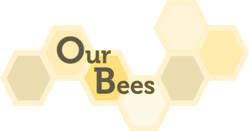Why invest in a BHP Queen?
The queen bee, to a large extent, determines the qualities of the whole colony. If you are looking for bees with characteristics such as resilience, a low swarming tendency, ease of handling, resistance to disease and high honey production, it is worth investing in a premium queen in which these attributes can be found.
Pedigree Buckfast Breeder Queens and Drone MothersEach year we source new pedigree (F0) Buckfast breeder queens as our queen mothers from Keld Brandstrup, Buckfast DK. These queens have been specially selected after testing their colonies for low swarm tendency, good comb behaviour, low aggressiveness, high honey yield, hygienic behaviour and lack of nosema. We firmly believe there is no better breeding stock being used in the UK.
Alongside our queen mothers we also use pedigree Buckfast island-mated queens in our colonies surrounding the queen site to provide the necessary drones for mating. Through the combination of operating in a secluded woodland location along with the proximity of our drone sites, we maximise the chance that our new queens will mate with drones of known parentage, maintaining a purity of breeding (F1) and ensuring the desired characteristics are passed to the next generation - Your bees! |
Temperament and ProductivityBHP Queens rear approximately 2000 queens each year in our woodland nursery for customers across the UK. Many of our customers return year after year due to the innate characteristics of our queens. Colonies raised from our queens have regularly been used in the media because of the excellent temperament of the bees.
|
Conserving and Reviving the Ancient WoodlandMuch of North Oxfordshire and West Buckinghamshire was formerly part of a Royal Hunting Forest. Only isolated remnants of this ancient woodland now remain. Our bees are located in one of these few remaining pockets of woodland. Through pollination, the bees from our queen site and drone mother colonies play a vital role in encouraging and sustaining the biodiversity in this important habitat.
|









